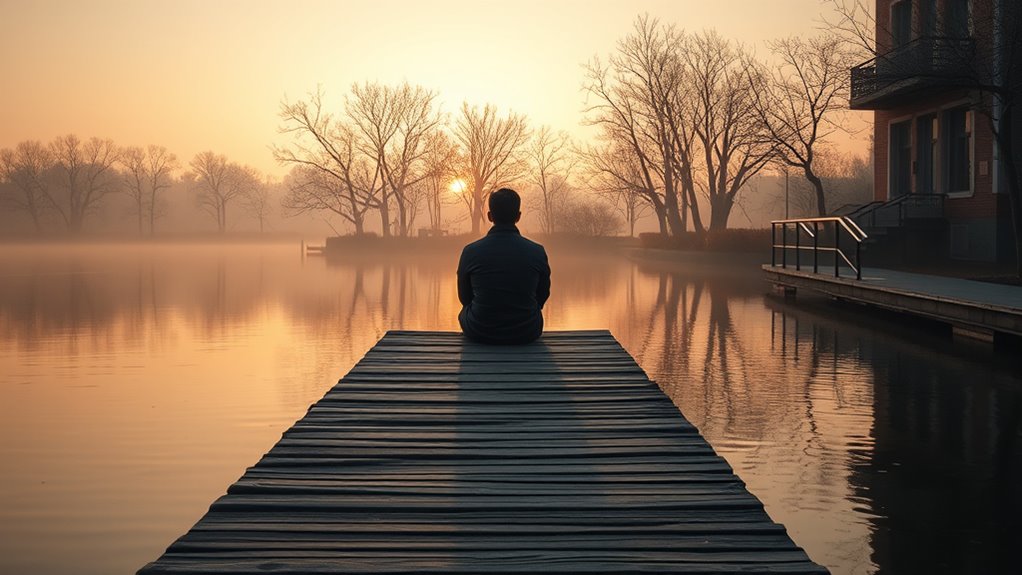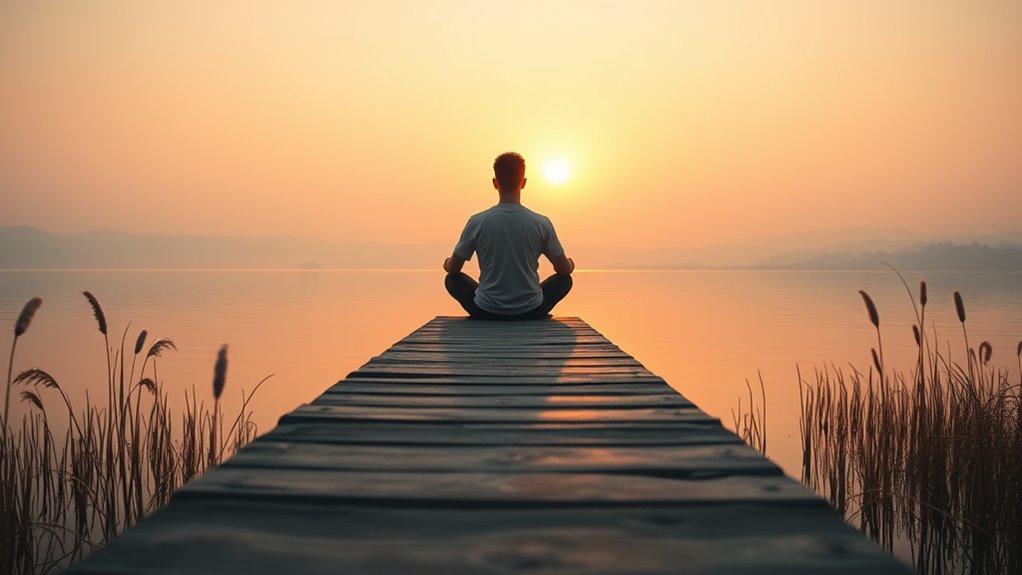Understanding the difference between loneliness and solitude is key to building healthy alone time. Loneliness feels like emotional disconnection and craving social contact, while solitude is a chosen time for reflection and self-awareness. When you intentionally spend time alone, you can boost your creativity, resilience, and clarity, but avoid unstructured or avoidant solitude that may lead to negative feelings. Keep exploring to learn how to balance alone time that nurtures your well-being and personal growth.
Key Takeaways
- Recognize the emotional differences: loneliness involves negative feelings, while solitude is a voluntary, restorative choice.
- Use intentional alone time to foster self-awareness, creativity, and emotional resilience.
- Identify signs of unhealthy solitude, such as withdrawal and persistent sadness, and address them early.
- Balance alone time with social interactions to maintain emotional health and prevent feelings of isolation.
- Practice mindfulness and self-reflection during solitude to build a positive, enriching relationship with being alone.
Understanding the Difference Between Loneliness and Solitude

While loneliness and solitude might seem similar, they are actually quite different experiences. Loneliness is an emotional state where you feel disconnected, craving social connection despite being alone. It often stems from a lack of meaningful interactions and can lead to feelings of sadness or isolation. In contrast, solitude is a voluntary choice, where you seek time alone to foster emotional awareness and self-reflection. When you embrace solitude, you’re not avoiding connection; instead, you’re nurturing your inner well-being. Recognizing this distinction helps you understand your feelings better. You can intentionally seek solitude to recharge and gain clarity, rather than feeling trapped or unfulfilled. Developing healthy boundaries around your alone time allows you to cultivate a positive relationship with solitude. Knowing the difference empowers you to create healthy boundaries and cultivate a positive relationship with your alone time.
The Emotional Impact of Being Alone

Being alone can evoke a wide range of emotions, depending on your mindset and circumstances. You might feel a sense of peace and emotional resilience, which helps you process feelings and build mental clarity. When you embrace solitude intentionally, you give yourself space to reflect, recharge, and gain perspective. This emotional clarity strengthens your resilience, making it easier to handle life’s challenges. However, if you’re unprepared or avoidant, loneliness can creep in, triggering negative emotions like anxiety or sadness. The key is to cultivate a healthy attitude toward solitude, recognizing its power to foster emotional growth. Engaging in meaningful activities, such as hobbies or self-care routines, can transform alone time into a positive experience. When you manage your alone time well, it becomes a source of empowerment, helping you develop a stronger, more balanced emotional state.
Recognizing When Alone Time Becomes Unhealthy

If you notice yourself pulling away from friends or avoiding social activities, your alone time might be turning unhealthy. Feelings of hopelessness or persistent sadness are signs that solitude is affecting your mental health. When your daily routines suffer or you can’t find motivation, it’s time to reassess how you’re spending your alone time. Additionally, excessive use of eye patches or reliance on superficial fixes can sometimes mask underlying emotional issues rather than address them directly.
Signs of Social Withdrawal
How can you tell when alone time shifts from being healthy to harmful? If you notice increased social withdrawal, it might be a sign you’re slipping into unhealthy patterns. Emotional detachment can deepen, making interactions feel draining or unnecessary. Watch for behaviors like avoiding friends, declining invitations, or feeling anxious about social situations. Recognize these signs before isolation worsens. Here’s a quick overview:
| Behavior | Emotional Impact | Possible Cause |
|---|---|---|
| Avoiding social events | Feelings of loneliness | Social withdrawal |
| Ignoring loved ones | Emotional detachment | Unhealthy alone time |
| Feeling anxious | Increased stress | Fear of social judgment |
| Isolating oneself | Sense of disconnection | Depression or burnout |
| Neglecting hobbies | Loss of joy | Over-avoidance of social contact |
Additionally, understanding the importance of color accuracy in your interactions can help you gauge how your perception might be affected during extended periods of solitude.
Feelings of Hopelessness
At what point does spending time alone start to feel overwhelming rather than restorative? When you begin to experience persistent feelings of hopelessness, your emotional resilience might be waning. Instead of gaining clarity or peace, solitude begins to deepen your sense of despair, impacting your mental health negatively. Recognizing this shift is essential; if alone time fuels negative thoughts or feelings of worthlessness, it’s a sign that your alone time has become unhealthy. Healthy solitude should help you recharge and reflect, not trap you in a cycle of hopelessness. To maintain balance, pay attention to your emotional state and seek support if your feelings intensify. Prioritizing mental health means adjusting your alone time to foster resilience rather than erode it. Incorporating mindful strategies, such as regular assessment and adjustment, can help ensure your alone time remains a positive and restorative experience.
Impact on Daily Life
When spending too much time alone starts to interfere with your daily responsibilities, it’s a clear sign your alone time may be turning unhealthy. You might notice a decline in social interactions, making it harder to connect with others or maintain relationships. This isolation can also diminish your emotional support network, leaving you feeling overwhelmed or unsupported during tough times. Overindulging in solitude can lead to feelings of loneliness, affecting your mental well-being and daily functioning. Recognizing these signs helps you understand when to seek balance. Reaching out to friends, family, or support groups can restore healthy social interactions and emotional support. Maintaining a mindful approach ensures that your alone time nurtures you rather than isolates you.
Benefits of Embracing Solitude for Personal Growth

Embracing solitude offers a unique opportunity for personal growth by allowing you to reflect deeply on your thoughts and feelings. This quiet time helps you build emotional resilience, teaching you to manage stress and setbacks more effectively. When you spend time alone, you develop stronger self reflection skills, enabling you to understand your motivations, desires, and fears better. This awareness fosters greater self-acceptance and confidence. Solitude encourages you to listen to your inner voice without external distractions, leading to clearer decision-making. Over time, these benefits enhance your overall well-being and inner strength. By embracing solitude intentionally, you create space for meaningful self-discovery, setting a foundation for continuous personal growth.
Practical Strategies to Cultivate Healthy Alone Time

Creating healthy alone time requires intentional planning and mindful boundaries. To do this, schedule regular periods for solitude that feel meaningful, not just filler. During this time, focus on activities that foster your emotional support and deepen your sense of well-being, like journaling, meditation, or hobbies you love. While alone, it’s essential to maintain social connection through occasional check-ins with friends or family—this ensures you don’t feel isolated or disconnected. Set clear boundaries to protect this time from distractions, such as turning off notifications or designating a quiet space. Incorporating mindful solitude practices, such as mindful breathing or gentle stretches, can further enhance your emotional resilience. By consciously balancing solitude with social interactions, you build a healthy routine that enriches your emotional resilience and nurtures your personal growth without feeling lonely or overwhelmed.
Developing Self-Awareness and Mindfulness in Solitude

As you spend time alone, pay attention to your inner feelings and notice how they shift throughout the day. Practicing mindfulness helps you stay present, rather than getting caught up in past worries or future concerns. By sharpening your self-awareness, you can better understand yourself and find peace in solitude. Incorporating self-reflection techniques can deepen your understanding of your emotional landscape during these moments.
Noticing Inner Feelings
Have you ever paused to truly observe what’s happening inside when you’re alone? Noticing your inner feelings is key to developing emotional awareness and inner reflection. As you sit quietly, you might notice:
- A flutter of excitement or unease in your stomach
- The gentle hum of thoughts drifting through your mind
- Subtle shifts in your breathing as emotions rise and fall
- Being mindful of self-awareness can deepen your understanding of these internal signals.
Cultivating Present Focus
To cultivate present focus in solitude, you need to intentionally bring your attention to the here and now. Practice mindful awareness by observing your thoughts, feelings, and sensations without judgment. This helps deepen your emotional resilience, allowing you to handle solitude more effectively. Engaging in activities like meditation, journaling, or mindful breathing anchors you in the present moment. Here’s a simple guide:
| Activity | Focus Area | Benefit |
|---|---|---|
| Meditation | Breath awareness | Calms the mind |
| Journaling | Emotions | Clarifies thoughts |
| Mindful Walking | Sensory perception | Enhances present awareness |
| Body Scan | Physical sensations | Builds emotional resilience |
| Deep Breathing | Relaxation | Reduces stress |
Consistent practice strengthens your ability to stay present, fostering healthier solitude.
Overcoming the Fear of Being Alone

Many people fear being alone because they associate solitude with loneliness or discomfort. To overcome this fear, focus on building emotional independence and maintaining social connections. Visualize yourself:
Embrace solitude as a source of strength by cultivating independence and nurturing meaningful connections.
- Sitting peacefully in a park, feeling calm and centered.
- Enjoying a hobby that sparks joy, like painting or reading.
- Connecting with friends through a heartfelt conversation.
These images remind you that solitude can be empowering, not isolating. Embracing alone time helps you develop resilience and self-awareness. Remember, being comfortable alone doesn’t mean cutting off social connection; it means balancing both. By shifting your mindset and nurturing your emotional independence, you’ll realize that solitude can be a source of strength and clarity, easing your fear of being alone. Cultivating emotional independence enables you to find peace within yourself, even when others are not nearby.
Creating a Balanced Approach to Alone Time in Daily Life

Building a healthy balance between alone time and social interaction is key to fostering emotional well-being. By cultivating emotional intelligence, you learn to recognize your feelings and needs, helping you determine when solitude or social engagement is most beneficial. Prioritize quality over quantity in your social connections to ensure meaningful interactions that support your mental health. Schedule regular alone time to recharge and reflect, but also make room for social activities that promote connection and support. Being mindful of your energy levels and emotional state helps you adjust your alone time accordingly, preventing feelings of loneliness or burnout. Striking this balance enhances your self-awareness and strengthens social connectivity, creating a sustainable routine that nurtures both independence and meaningful relationships.
Using Solitude to Foster Creativity and Reflection

When you spend time alone, you create space for your mind to wander and explore new ideas. This quiet reflection fosters creative insights and mental clarity. During solitude, your thoughts drift freely, allowing innovative solutions to surface. Imagine:
- Jotting down spontaneous ideas that come unexpectedly.
- Revisiting past projects with fresh perspective.
- Envisioning future goals without distraction.
These moments of creative reflection deepen your understanding and spark inspiration. Solitude helps you detach from external noise, sharpening your focus and enhancing mental clarity. Embracing alone time as a tool for introspection can help reduce feelings of loneliness and discover new layers of creativity, making your ideas more vivid and authentic. By intentionally cultivating solitude, you nurture your inner creative well and gain clarity to navigate complex challenges.
Building Resilience Through Meaningful Solo Experiences

When you spend time alone intentionally, you open the door to self-discovery and understanding your true values. As you face challenges solo, you build inner strength that helps you handle future setbacks with confidence. By finding purpose in your solitary moments, you create a resilient mindset that sustains you through life’s ups and downs.
Embracing Self-Discovery
Starting on solo experiences offers a powerful path to self-discovery, allowing you to explore your inner world without distractions. As you spend time alone, you engage in self reflection, gaining clarity about your values and desires. These moments build emotional resilience, helping you handle life’s challenges with greater strength. Imagine:
- Sitting quietly at sunrise, observing the changing colors and feeling your thoughts settle.
- Taking a solo hike, charting unfamiliar trails and trusting your instincts.
- Journaling your feelings after a day of self-discovery, connecting with your inner voice.
Each experience deepens your understanding of yourself and nurtures resilience. Embracing self-discovery through meaningful solitude helps you grow emotionally and develop a stronger sense of identity, ultimately enriching your relationship with yourself.
Cultivating Inner Strength
Engaging in meaningful solo experiences allows you to build resilience by confronting challenges and trusting your inner resources. As you navigate these moments alone, you develop emotional resilience, learning how to manage setbacks and uncertainties with confidence. Inner reflection becomes a crucial tool, helping you understand your reactions and strengths when faced with difficulties. By trusting your intuition and problem-solving abilities, you reinforce your capacity to adapt and recover. These solo encounters push you beyond comfort zones, fostering independence and self-reliance. Over time, you realize that adversity isn’t just something to endure but an opportunity to grow stronger internally. Cultivating inner strength through these experiences empowers you to handle future challenges with greater clarity and resilience.
Finding Purpose Alone
Finding purpose alone can be a powerful way to build resilience, as it pushes you to explore your values and passions without external influence. Through self-reflection, you gain clarity on what truly matters to you, fostering a sense of purpose exploration. Imagine setting out on a solo hike, where each step prompts internal questions:
- What drives me forward?
- Which passions ignite my enthusiasm?
- How can I align my actions with my core beliefs?
Focusing on these questions helps you develop a deeper understanding of yourself. Embracing solo experiences allows you to discover meaningful pursuits, strengthening your emotional resilience. Purpose exploration becomes a catalyst for growth, empowering you to navigate life’s challenges with confidence and clarity.
Frequently Asked Questions
How Can I Tell if My Alone Time Is Healthy or Harmful?
You can tell if your alone time is healthy or harmful by paying attention to your self-awareness and emotional regulation. If you feel more relaxed, clear-headed, and able to manage your emotions, you’re likely engaging in healthy solitude. However, if loneliness leads to anxiety, depression, or negative self-talk, it may be harmful. Regularly check in with yourself, and adjust your alone time to foster positive feelings and emotional balance.
What Are Common Signs of Loneliness Disguised as Solitude?
Ever think your cozy solitude is just emotional withdrawal in disguise? If you find yourself avoiding social contact, feeling more isolated than ever, or using alone time as an escape from real connection, you’re likely mistaking loneliness for healthy solitude. Social withdrawal and emotional numbness are signs that your alone time isn’t nourishing but damaging. Recognize these red flags, and reach out before your solitude turns into loneliness’s sneaky trap.
How Does Cultural Background Influence Perceptions of Loneliness?
Your cultural background shapes how you perceive loneliness, influenced by cultural norms and values. In some cultures, solitude is seen as a sign of strength and self-reflection, while others view it as social isolation. Perception differences can affect how comfortable you feel being alone and how you interpret feelings of loneliness. Recognizing these influences helps you build a healthier understanding of alone time that aligns with your cultural context.
Can Solitude Improve Mental Health, and How?
Solitude can boost your mental health by giving you time for mindfulness practices, which help you stay present and reduce stress. When you spend quality alone time, you build emotional resilience, making it easier to handle life’s challenges. Regular solitude encourages self-reflection and relaxation, improving your overall well-being. Embracing healthy alone time is a powerful way to recharge mentally, fostering a stronger, more balanced mind.
How Do I Balance Social Life With Necessary Alone Time?
Did you know that 78% of people feel overwhelmed by social obligations? You can balance your social life with alone time by setting clear social boundaries and practicing effective time management. Prioritize activities that recharge you, schedule alone time intentionally, and communicate your needs openly. This approach guarantees you stay connected without sacrificing mental health, helping you enjoy meaningful social interactions while maintaining healthy solitude.
Conclusion
By learning to dance with solitude instead of running from loneliness, you turn alone time into your personal sanctuary. Embrace the quiet moments as seeds of self-discovery, nurturing your inner garden. When you build a healthy relationship with solitude, you craft a resilient heart that thrives in its own company. Remember, solo journeys may be quiet, but they’re filled with the vibrant colors of growth, reflection, and the beautifully unique story only you can tell.









